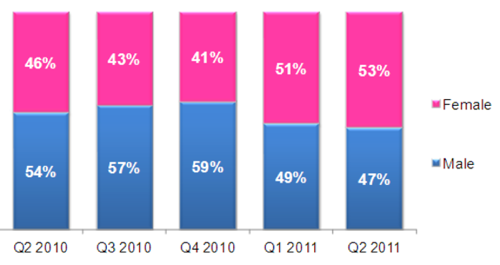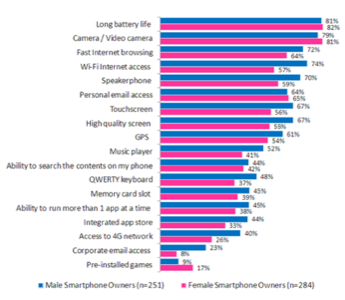A new study by Compete shows that women are adopting smartphones more quickly than men. In 2011, women outnumbered men in a study of smartphone owners by gender. This goes directly against findings in 2010, at which point there were more male than female smartphone owners. Of the types of activities done on smartphones, female-identified smartphone owners were more interested in sending text messages, accessing social networks, playing games, sharing photos and videos, conducting financial transactions and shopping online than their male counterparts. A greater percentage of men surveyed were more interested in streaming content (movies/TV) and making dinner reservations than female smartphone owners.

Of course, this study falls into the same space that all gender-specific studies from big research firms do. It conflates sex (biological and physiological characteristics that define men and women) and gender (socially constructed roles, behaviors, activities and attributes that a given society considers appropriate for men and women). These definitions of sex and gender are from the World Health Organization.

This study sees a clear distinction between “male” and “female,” and asserts that boys will be boys, and girls will be girls. It seems to de-emphasize gender-neutral phone features like sending text messages, access to social networks, long battery life and camera/video which score about the same across gender lines.
What if marketers thought more about the Kinsey scale and variations in gender instead of going by the same old hum-drum heteronormative model that conflates gender and sex?
For example, what about people who identify sex-wise as “female” but, if you asked them about their gender, they would respond with “boy” or “male”? How about people whose sex is male, but their gender is located more in the “girl” or “female” side of the gender spectrum? And how about folks who don’t see themselves in either realm? This study chooses to ignore them. Perhaps those concepts are too difficult for traditional marketers to grasp. If you want to go by a “two-gender” system, you’ll still find the results to this study fascinating and indicative of a much scarier trend: That we’re still living in the 1950’s.

What women really want more than their male counterparts, it says, is personal email access and pre-installed games. These results are in line with a study earlier this year from Flurry, which found that mobile gamers are more heavily female (53%) than traditional gamers (40% female).
Male smartphone owners are apparently most interested in fast Internet browsing, WiFi, speakerphone, touchscreen, high screen quality, GPS, music players, ability to search contents of the phone, QWERTY keyboard, memory card slot, ability to run more than one app at a time, integrated app store, access to 4G network and access to corporate email.

Basically, the study suggests that women want to use their smartphones for fun and personal use while men are busy conducting business on their phones. By these standards, it looks like things haven’t changed a bit since the 1950s.
What is study data like this being used for? Helping marketers create hypergendered products. The study goes on to discuss the gendered nature of Android (crazy red-eyed robot caters to people whose gender is more “male” or “boy,” if we’re going by the two-gendered system that this study works off of) in contrast with the new Verizon HTC Rhyme phone, which was released in September 2011 and is supposed to cater specifically to women. How does it do this? With a “charm call indicator which dangles from your purse and lights up when you get a call or text message.” So boys get the fierce, all-powerful robot from Hell and women get a dangly light-up purse toy trinket?
What marketers are really missing here is the difference between sex and gender, and how gender variance and a move away from the “two-gender” system can be used to make gendered actually marketing work.









